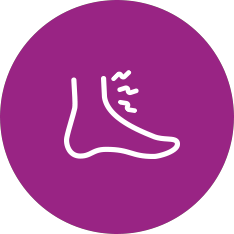Ankle Sprain
What is an ankle sprain?
Ankle sprains are a common injury that can occur in people of any age. Ankle sprains happen when the ligaments (tough bands of tissue) which add stability to your ankle joint are suddenly over stretched, or in some instances partially torn.
It is most common to damage the outside of your ankle which occurs when your foot rolls inwards (inversion injury), the inside ligaments can also be affected when your foot rolls outwards (eversion injury). Injuries can range from mild to severe.
What are the symptoms?
Following an ankle injury you will normally experience:
- Sharp pain and sudden swelling
- Bruising
- Tenderness to touch
- Initially difficulty to weight bear on the affected side
- Instability – if substantial instability is experienced please check urgent symptoms and follow advice as this can indicate a complete tear
It can take several weeks or months for a sprained ankle to heal completely depending on the severity of your sprain. Generally weight bearing activity will improve approximately a week after a sprain, and symptoms improve after 6-8 weeks and return to sport at 12 weeks. If you have followed the advice on this page and you feel your ankle is not recovering properly after injury, or you are struggling to return to activity you can self-refer below.
What are the causes?
Injuries can occur when:
- Playing sport - causing the ankle to twist or rolling over of the ankle
- Injuries such as stepping over the edge of a kerb or step
- You have a history of previous ankle sprains - the ankle becomes more vulnerable to reoccurring symptoms if not rehabilitated
What can I do to help myself?
Mild sprains can be treated at home with the following advice:
- Follow the RICE advice for initial treatment on the ankle home page (RICE advice)
- Reduce any specific activities that aggravate your symptoms and stress your ankle, especially sporting activities allowing the ligaments time to recover.
- Follow the exercise advice sheet below, it is important to do these exercises regularly
What will physiotherapy do?
A physiotherapist will take a thorough history of your symptoms and will conduct a physical examination of the area to confirm the diagnosis.
The main aim of physiotherapy is to restore strength and function to the ankle and surrounding muscles. Treatment will be based on active rehabilitation, focusing on strength and flexibility.
Your physiotherapist will create an individual and progressive exercise programme to address your individual needs.
Symptoms to check
Click the plus sign to see a list of problems that could be a sign you may need to be checked urgently
Get advice from 111 now if:
- your ankle is very painful and you cannot put any weight on it
- you have direct injury to the ankle and it has become very swollen very quickly
- your ankle is badly swollen or has changed shape
- you heard a snap, grinding or popping noise at the time of injury
- you have a very high temperature, feel hot and shivery, and have redness or heat around the ankle – this can be a sign of infection
111 will tell you what to do. They can tell you the right place to get help if you need to see someone.
Go to 111.nhs.uk or call 111.
Immediate medical advice is available by contacting NHS 111


 Ankle
Ankle